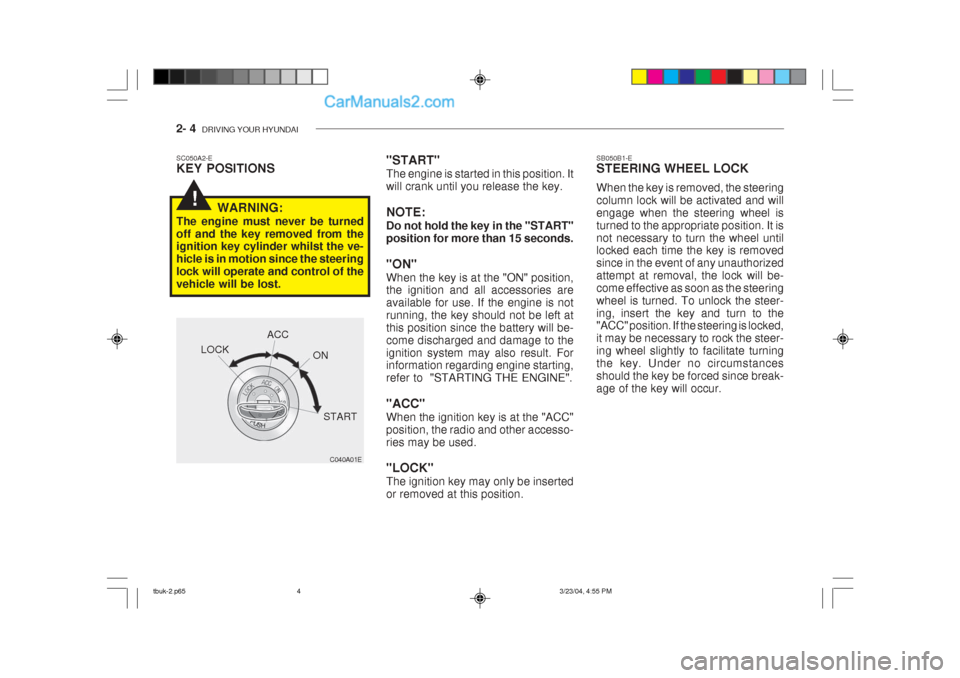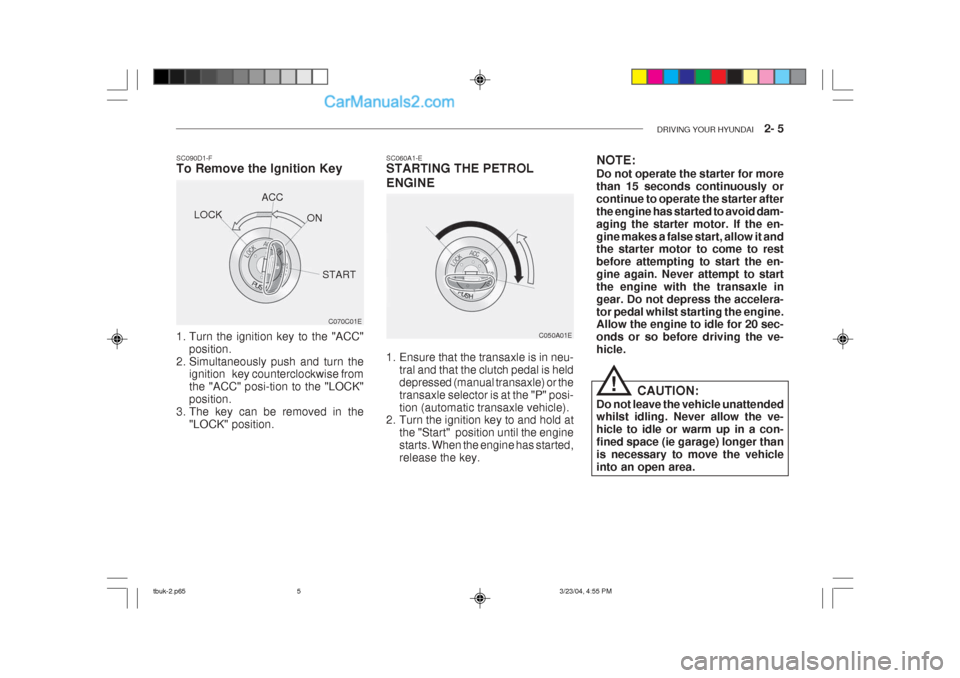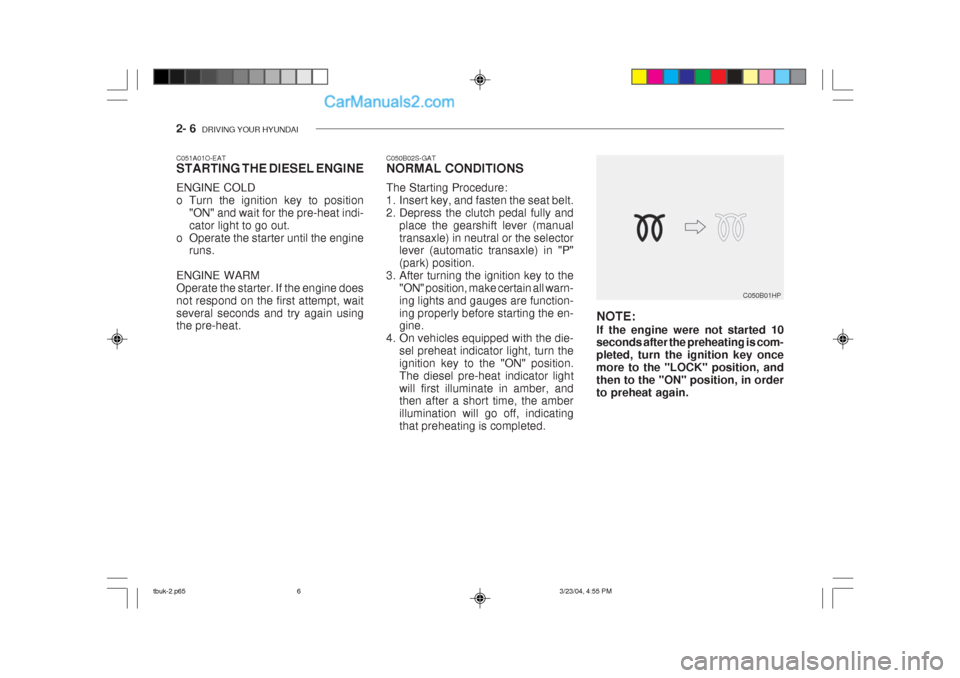2004 Hyundai Getz lock
[x] Cancel search: lockPage 347 of 445

2- 4 DRIVING YOUR HYUNDAI
!
"START" The engine is started in this position. It will crank until you release the key. NOTE: Do not hold the key in the "START" position for more than 15 seconds. "ON" When the key is at the "ON" position, the ignition and all accessories are available for use. If the engine is notrunning, the key should not be left atthis position since the battery will be-come discharged and damage to theignition system may also result. For information regarding engine starting, refer to "STARTING THE ENGINE". "ACC" When the ignition key is at the "ACC" position, the radio and other accesso-ries may be used. "LOCK" The ignition key may only be inserted or removed at this position.SC050A2-E KEY POSITIONS
C040A01E
LOCK
ACC
ON
START
WARNING:
The engine must never be turned off and the key removed from the ignition key cylinder whilst the ve- hicle is in motion since the steeringlock will operate and control of thevehicle will be lost. SB050B1-E STEERING WHEEL LOCK When the key is removed, the steering column lock will be activated and willengage when the steering wheel isturned to the appropriate position. It isnot necessary to turn the wheel until locked each time the key is removed since in the event of any unauthorizedattempt at removal, the lock will be-come effective as soon as the steeringwheel is turned. To unlock the steer-ing, insert the key and turn to the "ACC" position. If the steering is locked, it may be necessary to rock the steer-ing wheel slightly to facilitate turningthe key. Under no circumstancesshould the key be forced since break-age of the key will occur.
tbuk-2.p65
3/23/04, 4:55 PM
4
Page 348 of 445

DRIVING YOUR HYUNDAI 2- 5
SC060A1-E STARTING THE PETROL ENGINE
C050A01E
1. Ensure that the transaxle is in neu- tral and that the clutch pedal is held depressed (manual transaxle) or thetransaxle selector is at the "P" posi-tion (automatic transaxle vehicle).
2. Turn the ignition key to and hold at
the "Start" position until the enginestarts. When the engine has started,release the key.
C070C01E
SC090D1-F To Remove the Ignition Key
1. Turn the ignition key to the "ACC"
position.
2. Simultaneously push and turn the ignition key counterclockwise from the "ACC" posi-tion to the "LOCK"position.
3. The key can be removed in the
"LOCK" position.LOCK
ACC
ON
START NOTE: Do not operate the starter for more than 15 seconds continuously orcontinue to operate the starter afterthe engine has started to avoid dam-aging the starter motor. If the en-gine makes a false start, allow it and the starter motor to come to rest before attempting to start the en-gine again. Never attempt to startthe engine with the transaxle ingear. Do not depress the accelera-tor pedal whilst starting the engine. Allow the engine to idle for 20 sec- onds or so before driving the ve-hicle.
CAUTION:
Do not leave the vehicle unattended whilst idling. Never allow the ve- hicle to idle or warm up in a con-fined space (ie garage) longer thanis necessary to move the vehicleinto an open area.
!
tbuk-2.p65 3/23/04, 4:55 PM
5
Page 349 of 445

2- 6 DRIVING YOUR HYUNDAI
C050B01HP
NOTE: If the engine were not started 10 seconds after the preheating is com- pleted, turn the ignition key oncemore to the "LOCK" position, andthen to the "ON" position, in orderto preheat again.
C051A01O-EAT STARTING THE DIESEL ENGINE ENGINE COLD
o Turn the ignition key to position
"ON" and wait for the pre-heat indi-cator light to go out.
o Operate the starter until the engine runs.
ENGINE WARMOperate the starter. If the engine doesnot respond on the first attempt, waitseveral seconds and try again using the pre-heat. C050B02S-GAT NORMAL CONDITIONS The Starting Procedure:
1. Insert key, and fasten the seat belt.
2. Depress the clutch pedal fully and
place the gearshift lever (manualtransaxle) in neutral or the selector lever (automatic transaxle) in "P" (park) position.
3. After turning the ignition key to the
"ON" position, make certain all warn-ing lights and gauges are function-ing properly before starting the en- gine.
4. On vehicles equipped with the die-
sel preheat indicator light, turn the ignition key to the "ON" position.The diesel pre-heat indicator lightwill first illuminate in amber, and then after a short time, the amber illumination will go off, indicatingthat preheating is completed.
tbuk-2.p65 3/23/04, 4:55 PM
6
Page 353 of 445

2- 10 DRIVING YOUR HYUNDAI
YC090A1-E SELECTOR POSITIONS o P (Park): With the selector in this position, no drive is transmitted from the engineand the transaxle output and thereforethe front wheels locked. The enginemay be started with the selector in this position.
!
CAUTION:
The selector must NEVER be shifted to the "P" position whilst the ve-hicle is in motion, otherwise seri-ous transaxle damage will result. DC110C1-E o R (Reverse): With the selector in this position, re- verse gear will be engaged. The en-gine may not be started with the selec-tor in this position.
CAUTION:
The selector must NEVER be shiftedto the "R" position whilst the ve-hicle is in motion.
! DC110D1-E o N (Neutral): With the selector in this position, no gear is selected and no drive is trans-mitted from the engine. The enginemay be started with the selector in thisposition.
!
CAUTION:
Do not coast with the selector at the "N" position. DC110E1-E o D (Drive): With the selector in this position, first gear will be engaged from rest and thetransmission will automatically upshiftto second, third and fourth depending upon the vehicle speed, throttle posi- tion and the position of the overdriveswitch. The engine may not be startedwith the selector in this position. DC110F1-E o 2 (Second Gear): With the selector in this position, first gear will be engaged from rest. Thetransmission will upshift to second geardepending upon the vehicle speed andthrottle position. No upshift to third or fourth will occur. The engine may not be started with the selector in thisposition. DC110G2-E o L (Low Gear): With the selector in this position, first gear will be engaged from rest. Noupshift will occur regardless of vehiclespeed and throttle opening. The en-gine may not be started with the selec-tor in this position.
!
CAUTION:
Do not move the selector to the "L" position when the vehicle speed isin excess of 50 m.p.h.
tbuk-2.p65 3/23/04, 4:55 PM
10
Page 356 of 445

DRIVING YOUR HYUNDAI 2- 13
SC140B1-E ANTI-LOCK BRAKE SYSTEM (Not all models) The Anti-Lock Brake System (ABS) is designed to prevent wheel lock-upduring sudden braking or on hazard-ous road surfaces. The ABS controlmodule monitors the wheel speed and controls the pressure applied to each brake. Thus, in emergency situationsor on slick roads, ABS will increasevehicle control during braking. NOTE: During ABS operation, a slight pul- sation may be felt in the brake pedal when the brakes are applied. Also, a noise may be heard in the enginecompartment whilst braking. Theseconditions are normal and indicatethat the anti-lock brake system isfunctioning properly.
located in the instrument cluster will beilluminated. When the overdrive switchis turned "ON", the transaxle functionsas a fully automatic four speed unitwith the maximum fuel economy po- tential of the vehicle being realized. SC140A1-E EFFECTIVE BRAKING Braking system performance and fric- tion material life are greatly affected by the driving style adopted. The follow-ing suggestions are made to assist inachieving the best results from thebraking system.
o Anticipate the road and conditions
ahead in order that heavy braking may be avoided.
o When descending long gradients,
use the engine to assist in retardingthe vehicle to minimize the possibil- ity of brake fade occurring.
o When trailer towing, ensure that the
trailer brakes function correctly and use engine braking to assist thevehicle braking system. o Use only genuine Hyundai replace-
ment brake pads and shoes to en-sure consistent friction characteris-tics and wear rates.
o After driving through deep water (e.g. fording), the brakes may be-come wet and performance reduced.Always check brake efficiency afteremerging from the water and dry thebrakes by lightly depressing thebrake pedal several times whilst driving slowly.
o Apply the parking brake only when the vehicle is at rest.
o Since the power assistance pro- vided by the brake servo is derived from the engine, coasting with the engine turned off or towing of the vehicle with the engine turned offwill result in greatly increased pedalpressures being required to stop thevehicle.
o Do not hold the vehicle on the up- grade with the accelerator pedal.This can cause the transmission tooverheat. Always use the brakepedal or parking brake.
tbuk-2.p65 3/23/04, 4:55 PM
13
Page 357 of 445

2- 14 DRIVING YOUR HYUNDAI
!WARNING:
ABS will not prevent accidents due to improper or dangerous drivingmaneuvers. Even though vehicle control is improved during emer- gency braking, always maintain asafe distance between you and ob-jects ahead. Vehicle speeds shouldalways be reduced during extremeroad conditions. The braking distance for cars equipped with an anti-lock brakingsystem may be longer than for thosewithout it in the following road con-ditions.
o Driving on rough, gravel or snow- covered roads.
o Driving with tyre chains installed.
o Driving on roads where the road
surface is pitted or has differentsurface height. These roads should be driven at reduced speeds. The safety features of an ABS equipped vehicle shouldnot be tested by high speed drivingor cornering. This could endangerthe safety of yourself or others. SC150A1-F DRIVING FOR ECONOMY You can save fuel and get more miles from your car if you follow these sug-gestions:
o Drive smoothly. Accelerate at a
moderate rate. Don't make "jack- rabbit" starts or full-throttle shiftsand maintain a steady cruisingspeed. Don't race between stop-lights. Try to adjust your speed tothat of the other traffic so you don't have to change speeds unneces- sarily.Avoid heavy traffic whenever pos-sible. Al-ways maintain a safe dis-tance from other vehicles so youcan avoid unnecessary braking. This also reduces brake wear. o Drive at a moderate speed. The
faster you drive, the more fuel your car uses. Driving at a moderatespeed, especially on the highway, isone of the most effective ways to reduce fuel consumption.
o Don't "ride" the brake or clutch pedal. This can increase fuel consumption and also increase wear on thesecomponents. In addition, driving withyour foot resting on the brake pedal may cause the brakes to overheat, which reduces their effectivenessand may lead to more serious con-sequences.
o Take care of your tyres. Keep them inflated to the recommended pres- sure. Incorrect infla-tion, either too much or too little, results in unnec-essary tyre wear. Check the tyrepres-sures at least once a month.
o Be sure that the wheels are aligned correctly. Improper alignment can result from hitting curbs or driving too fast over irregular surfaces. Pooralignment causes faster tyre wearand may also result in other prob-lems as well as greater fuel con-sumption.
tbuk-2.p65 3/23/04, 4:55 PM
14
Page 359 of 445

2- 16 DRIVING YOUR HYUNDAI
ZC170C1-E Anti-freeze/Corrosion inhibitor The cooling system must always con- tain an Ethylene-Glycol based anti-freeze solution. The system is filledduring manufacture with solution ofthe correct strength which should be checked before the onset of winter and adjusted or changed as required. NOTE: The anti-freeze solution contains a corrosion inhibitor to prevent deg-radation of the aluminum castings contained within the engine. There- fore, never, drain the system andrefill with water only. In addition, anti-freeze solution must ALWAYS be used in vehicles fitted with air conditioning, to prevent the heater matrix from freezing and sub-sequently bursting with the refrigera-tion system in use. SC170E1-E Windscreen Washers and Wip- ers The windscreen washer bottle should be filled with a solution of water and aproprietary winter screen wash addi-tive. The windscreen wipers shouldnot be used if the blades are frozen to the windscreen or if they are covered with snow, before this is removed. NOTE: Never allow undiluted screen washer fluid additive to spill uponthe paintwork or use engine cool-ant anti-freeze since damage to the paintwork may result.
o When driving in extreme conditions,
the windscreen wiper blades may fail to clear the screen properly dueto the formation of ice upon the blade edge. It will therefore be nec- essary to periodically remove suchice to restore their efficiency.
o If the power operated door mirrors become frozen, attempts to adjustthese may damage the mechanism.
ZC170D1-E Door Locks Should the door lock mechanism be- come frozen, a proprietary lock de-icershould be used. Alternatively, warm-ing the door key may thaw the doorlock. However, the key should behandled carefully to avoid burning the fingers. Never attempt to thaw a frozen doorlock using hot water, since the waterwill eventually freeze and compoundthe problem. NOTE: The proper temperature for using the immobilizer key is from -40°F to 176°F (-40°C to 80°C). If you heat theimmobilizer key over 176°F (80°C)to open the frozen lock, it may causedamage to the transponder in itshead.
tbuk-2.p65
3/23/04, 4:55 PM
16
Page 369 of 445

3- 6 WHAT TO DO IN AN EMERGENCY
SD060A1-E
IN THE EVENT OF A PUNCTURE
If a puncture occurs whilst driving the
vehicle:
1. Bring the car to rest as soon as it is
safe to do so and with the minimum
amount of braking required which
will assist in maintaining the maxi-
mum amount of control. The vehicle
should be parked wherever pos-
sible upon firm level ground to facili-
tate wheel changing.
2. If the vehicle is creating a hazard and the road conditions do not per-
mit the wheel to be changed safely,
assistance should be sought.
3. Passengers must not be allowed to
remain inside the vehicle during
wheel changing. If a puncture oc-
curs whilst the vehicle is on a
motorway, the passengers should
take refuge on the motorway em-
bankment to avoid the possibility of
injury occurring should the vehicle
be struck by other motorway traffic.
4. Wheel changing should be per-
formed according to the following
instructions.
SD050A2-E
SPARE WHEEL (Not all models)
The spare wheel is stored under the
luggage compartment floor and is ac-
cessed from within the luggage com-
partment by lifting the carpet and the
floor panel.
To remove the spare wheel, unscrew
the retainer, rotating this in an anti
clockwise direction and lift out the
wheel. To replace the wheel, screw
the retainer by hand until tight having
located the wheel in the luggage com-
partment floor well. The inflation pres-
sure of the spare wheel should be
checked at least monthly and when-
ever the wheel is fitted to the vehicle.
Inflation Pressure
Tyre Size
Spare Tyre Pressure
Full Size
210 kPa (30 psi)
CAUTION:
o Do not use snow chains with your temporary spare tyre.
o Do not use more than one tempo- rary spare tyre at a time.
!
5. The temporary spare tyre should
not be used on any other wheels,
nor should standard tyre, snow tyre,
wheel covers or trim rings be used
with the temporary spare wheel. If
such use is attempted, damage to
these items or other car compo-
nents may occur.
6. The temporary spare tyre pressure should be checked once a month
while the tyre is stored.
tbuk-3.p65 3/23/04, 4:24 PM
6